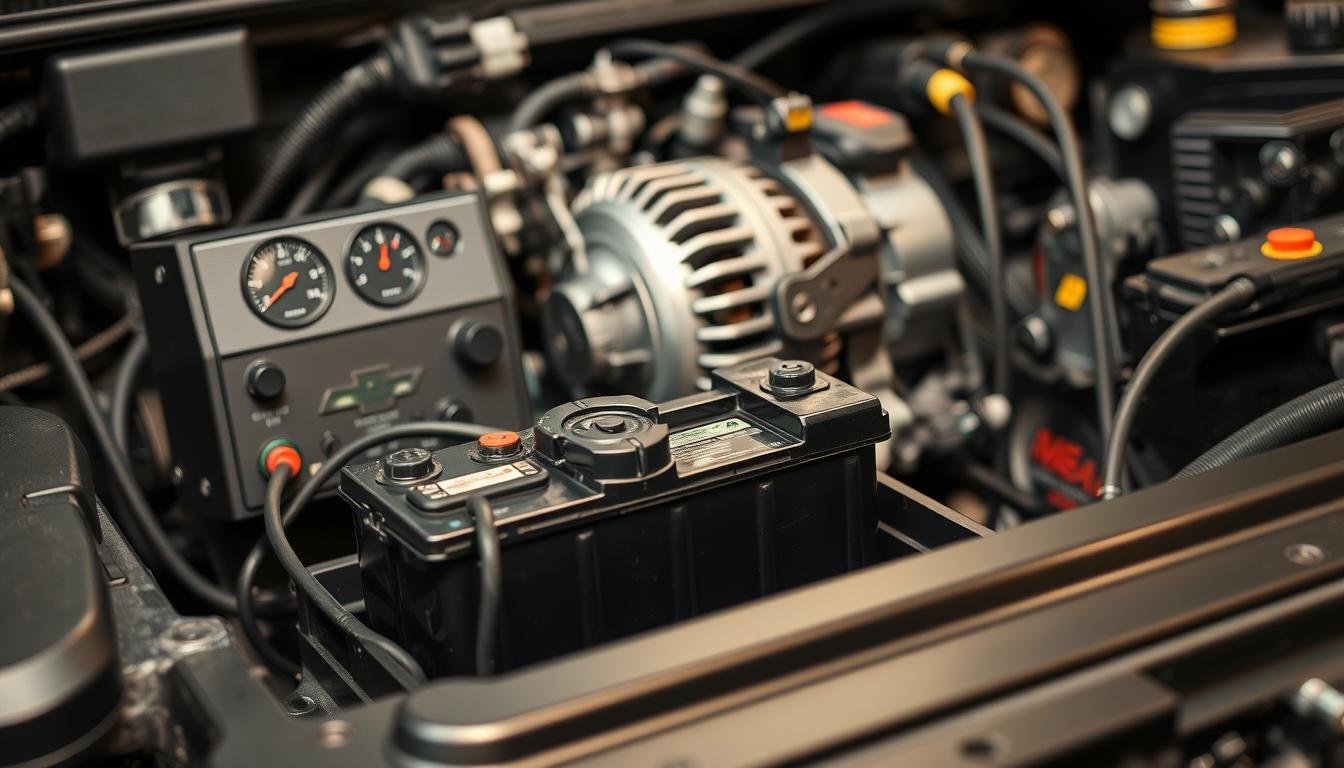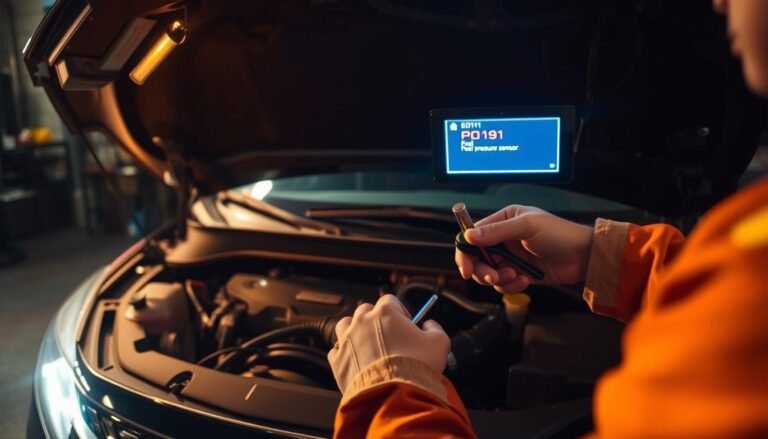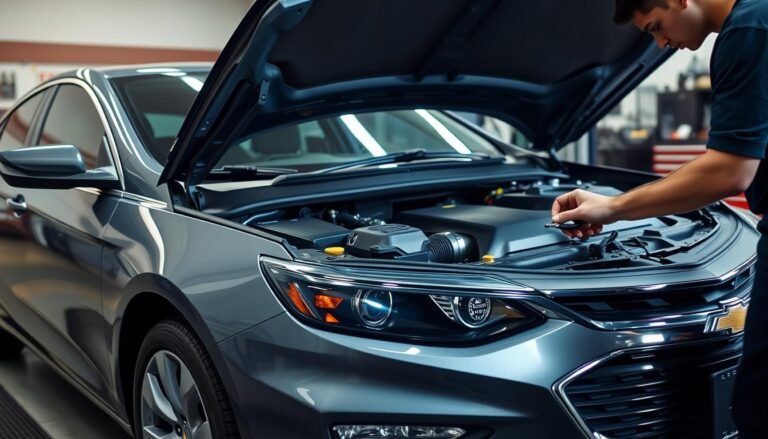Service Battery Charging System Chevy: Fix & Tips
Learning your service battery charging system chevy is key for a smooth, reliable ride. If you see dimming lights or have trouble starting your car, it’s time to check the service battery charging system.
Keeping this system in good shape helps your car start well and keeps all electrical parts running right.
In this guide, we’ll talk about how to check your Chevy’s battery system, highlight common problems, and give you tips on a thorough inspection.
Knowing how to troubleshoot and maintain your Chevy’s battery charging system is crucial. It helps extend your vehicle’s life and keep its performance up.
You’ll learn to spot issues, test the alternator, and understand preventive steps to avoid future troubles. Let’s get into the key details that will help you look after your Chevy’s battery health.
What’s The Battery Charging System in Your Chevy?
Your Chevy’s battery charging system is vital for your car to work right. It has three main parts: the battery, alternator, and voltage regulator.
Together, they keep the voltage between 13.6 and 14.6 VDC when your engine is running. This balance means your car’s electrical parts work well without draining the battery.
If your alternator isn’t working right, it might not charge the battery enough, leaving you stuck. Or, if it charges too much, your battery could get damaged and not last as long.
So, knowing how these parts work together helps you take care of your car’s battery. Watching these signs helps you find problems early.
If your car starts oddly, lights flicker, or you see a battery warning light, check your charging system. Keeping up with regular checks stops big problems and expensive fixes.
Common Signs of Trouble with Your Chevy Battery
Seeing the signs of battery issues early is key for your Chevy’s care. Watch out for:
- Dimming headlights
- Slow engine cranking
- Dashboard warning lights, particularly the “Service Battery Charging System” light
These signs mean you should check your chevy battery right away. If you don’t, your battery might completely fail. This could affect how well your car works.
By checking your chevy car’s battery regularly, you can spot problems early. This helps keep your Chevy in top shape.
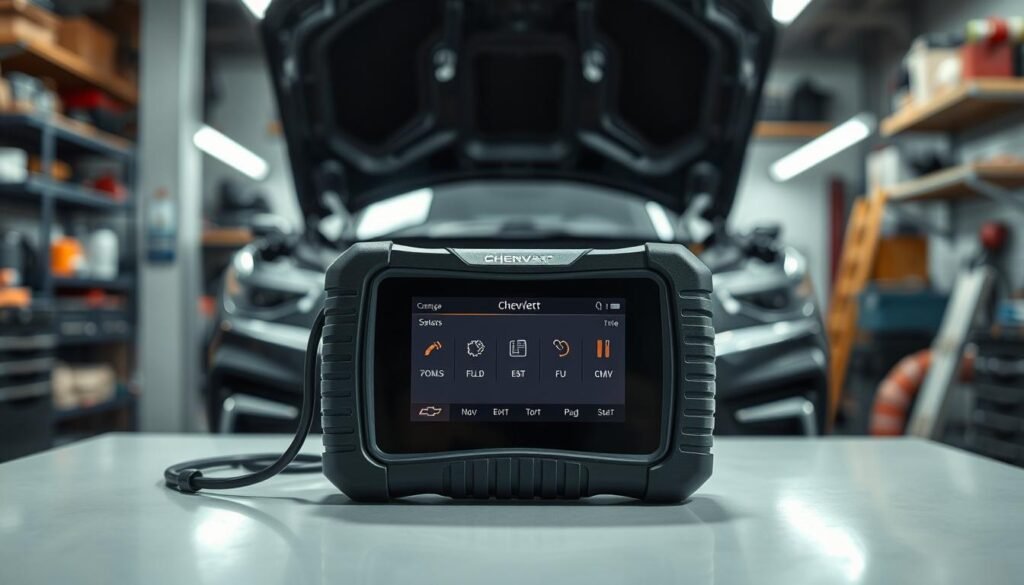
Service Battery Charging System Chevy: What It Means
When you see the “Service Battery Charging System” alert on your Chevy dash, it warns of a possible charging system fault. This could involve the battery, alternator, or wiring.
Knowing what causes this alert helps avoid more troubles. Reasons for the warning can be minor, like corrosion on battery terminals, or big, like a bad alternator.
Spotting the exact problem quickly means you can fix it and keep your car running smoothly. If you’re looking for a solid fix, think about getting help from a pro in Chevy electrical systems.
They make sure to check every part of your battery charging system. This step catches any issues early, saving you from sudden car troubles and high repair costs.
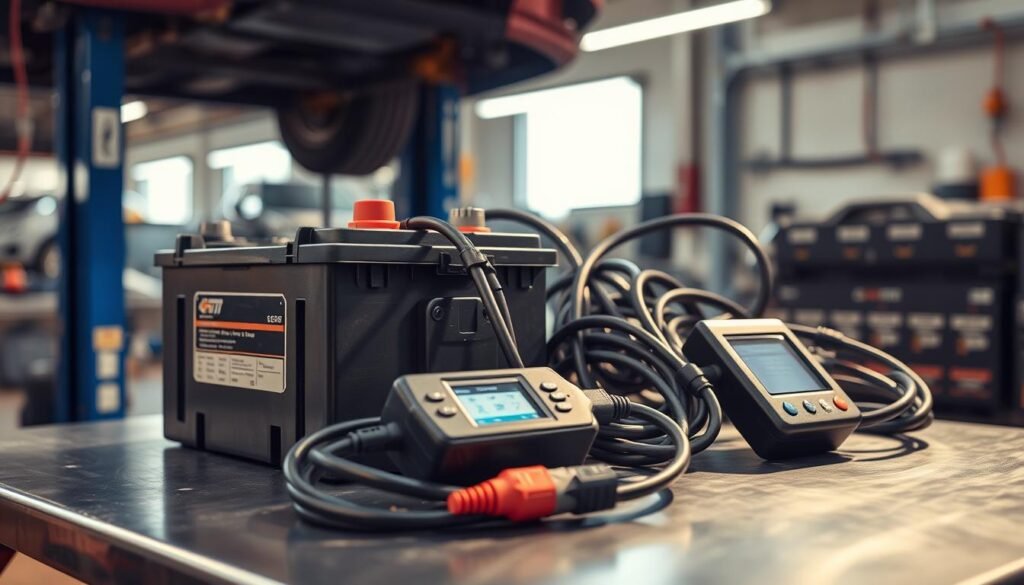
Checking Battery Connections and Terminals
Making sure your Chevy’s battery system is properly connected is crucial for good performance. First, look closely at the battery terminals to check for corrosion.
You might see a powdery substance that can be white, green, or blue. To keep everything running smoothly, check these connections regularly.
How To Identify Corrosion?
Seeing corrosion on the terminals means you should act fast. You can clean it with a mix of baking soda and warm water.
Don’t forget to wear gloves and safety glasses to protect yourself. Doing this chevy battery service often will keep your battery working longer.
Tightening Loose Battery Cables
It’s also important to check that the battery cables are tight. If they’re loose, your car’s battery might not charge right, causing problems.
Tighten any loose connections with a wrench. Just be careful not to overdo it and damage the terminals.
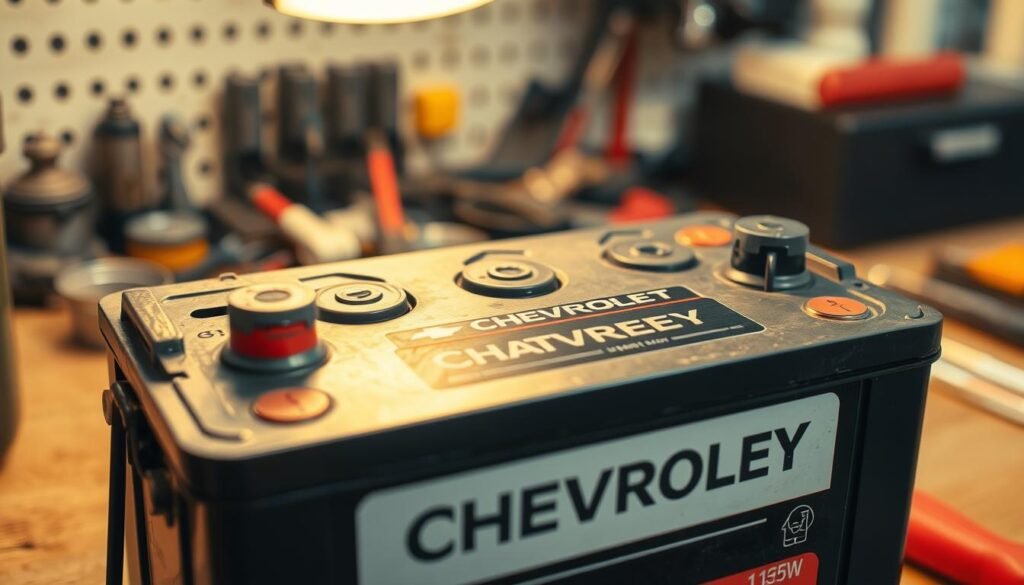
Testing The Alternator Functionality
It’s important to make sure your alternator is working right to keep your Chevy’s battery system charging smoothly. A bad alternator can cause a lot of trouble.
It can lead to weak power generation. This affects not just the battery but your car’s whole electrical setup. Testing it often can catch problems early on.
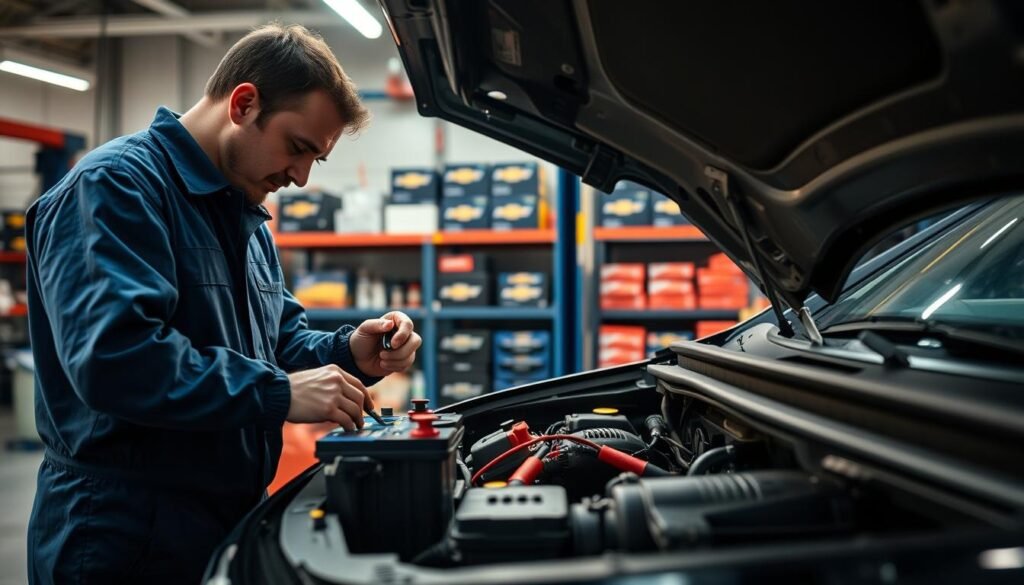
Voltage Check: What You Should Know?
Checking your alternator’s health means doing a voltage test while your car is on. A multimeter will give you the right numbers. You’re looking for a reading between 13.6 and 14.6 VDC.
A reading over 15 VDC is a clear sign something’s wrong. This means you might need to get a new alternator to keep your battery system healthy.
Here’s a simple guide to follow for the voltage test:
| Voltage Range | Status |
|---|---|
| 13.6 – 14.6 VDC | Normal Functioning |
| Above 15 VDC | Replace Alternator |
| Below 13.6 VDC | Charging Issues |
Keeping your alternator in good shape is key to a dependable Chevy battery service. Doing regular checks helps your battery last longer. It also makes fixing your Chevy’s charging system easier.
Checking Fuses in The Battery Charging System
Your Chevy’s battery charging system depends on various parts, like fuses. A fuse that has blown can stop the battery from charging right.
First, find the fuse box, which you’ll likely find under the dash or in the engine area. Your owner’s manual will tell you exactly where it is. Then, look closely at the fuses for any damage.
If a fuse is blackened or broken, it’s time to switch it out. It’s best to use a fuse puller to do this safely. Knowing where each fuse goes is also helpful for correct replacements.
It’s important to check and change fuses regularly to keep everything working well. If you ignore a blown fuse, you might face bigger electrical problems later.
This could even mess with your chevy battery’s diagnosis. A little bit of upkeep can prevent costly fixes down the line.
| Fuse Type | Common Ratings | Purpose |
|---|---|---|
| Blade Fuse | 5A, 10A, 15A, 20A | Standard circuits, including lights and battery charging. |
| Mini Fuse | 5A, 10A, 15A | Used in modern vehicles for compact spaces. |
| Maxi Fuse | 40A, 50A | High-power circuits, typically for the fuel pump and starter. |
| Glass Tube Fuse | Fuses vary by application. | Older vehicles, often for ignition and other key systems. |
Performing Chevy Battery Diagnostics
Keeping your vehicle in top shape means checking the battery often. Spotting problems early can stop bigger issues later, especially with your Chevy’s battery system. An OBD-II scanner is great for finding battery troubles.
Using an OBD-II Scanner For Troubleshooting
An OBD-II scanner gives you useful info about your Chevy’s battery system. Here’s how it works:
- Find the OBD-II port, usually under the dash near the driver.
- Plug the scanner into the port firmly.
- Turn the key to “on” but don’t start the car.
- The scanner shows error codes that point out problems with the battery or its charging.
- If needed, clear the codes to check if the issue comes back, which means the problem’s still there.
Fixing the errors found can really boost how your Chevy runs. Doing a deep dive into your car’s battery health lets you fix what’s actually wrong. This saves money and keeps your car dependable.
Regular Chevy Battery Maintenance Tips
Maintaining your battery is key to a long life for your Chevy. It includes cleaning terminals and making sure connections are tight. This helps avoid problems that could hurt your battery’s performance.
It’s good to check your battery’s voltage every month. This is extra important if you don’t drive your Chevy a lot. Catching issues early keeps your battery healthy.
Driving longer distances once a month is good for your battery. It gets a full charge this way. If you rarely drive, a high-quality battery maintainer is worth the investment. It keeps your battery charged.
- Check battery terminals for corrosion and clean them as needed.
- Ensure all connections are tight to prevent power loss.
- Conduct voltage tests periodically to monitor battery health.
- Use a battery maintainer if your vehicle is not driven regularly.
Using these tips can make a big difference. They help your chevy’s charging system work better and improve your car’s performance.
When To Replace Your Chevy Battery?
Knowing when to swap out your Chevy battery is key for a smooth ride. There are clear signs when it’s time to get a new battery. If you ignore them, you might end up stranded.
- Visible Damage: Check if the battery case is cracked or bulging.
- Odor: A bad smell, like rotten eggs, means the battery might fail soon.
- Aging: After 3-5 years of use, most batteries need changing.
- Voltage Levels: A voltage meter reading below 12.4 volts suggests the battery is dying.
Staying ahead of these issues helps you fix problems before they worsen. Regular battery checks keep your car running longer.
Chevy Charging System Repair Options
If your Chevy’s charging system has problems, there are several ways to fix it. You might want to take it to a dealership or a certified mechanic.
They have the right tools and knowledge to tackle complex issues. Often, they spot problems that aren’t obvious to car owners. For those who like doing things themselves, DIY repairs are a good choice.
This is true if you know a bit about cars. Start by looking at common issues with Chevy’s charging system. Sometimes, fixing a blown fuse or making sure battery cables are tight does the trick.
Online forums and communities for Chevy owners can offer helpful repair advice for your model.
Here’s a quick overview of potential repair methods:
| Repair Method | Description | Skill Level Required |
|---|---|---|
| Professional Service | Complete diagnosis and repairs by a certified technician. | Low |
| DIY Basic Fixes | Replace fuses or tighten cables yourself. | Medium |
| Parts Replacement | Purchase and replace defective components. | Medium to High |
| Forum Consultation | Seek advice from communities about common issues. | Low |
Deciding on the best fix depends on your mechanical skills and the issue at hand. By considering your options, you make sure your Chevy’s charging system gets fixed right. This keeps your car running well.
Conclusion
Keeping your Chevy’s service battery charging system in good shape is key for a dependable car. This system powers your vehicle’s electrical parts and stops sudden failures.
Knowing about the system and doing regular checks helps you fix problems early. Staying on top of your Chevy’s battery needs lets you spot early warnings.
Checking connections, testing the alternator, and doing diagnostics extend your battery’s life. Being informed means you can deal with small issues quickly and well.
To sum up, caring for your Chevy’s service battery charging system boosts your car’s performance.
By making these practices routine, you not only make your car more reliable but also feel more in control. Good care now means saving time and money later.
FAQs
How can I tell if my Chevy’s battery is failing?
Look for signs like dim headlights and slow engine starting. The “Service Battery Charging System” light on your dash is another clue. Also, use a multimeter to check the battery voltage. Readings under 12.4 volts mean the battery might be weak.
What should I do if my Chevy’s battery terminals are corroded?
Use a mix of baking soda and warm water to clean the terminals. Always wear gloves and safety glasses for protection. Make sure all connections are tight after cleaning to keep the charging system working well.
How can I test my Chevy’s alternator to ensure it’s functioning correctly?
Start the car and measure the voltage at the battery with a multimeter. A good alternator gives 13.6 to 14.6 VDC. If you get more than 15 VDC, the alternator might need replacement.
How often should I check my Chevy’s battery and charging system?
Check your system every 3 to 6 months. Routine care includes looking at battery terminals, testing voltage, and checking the charging system’s fuses.
What causes the “Service Battery Charging System” light to appear?
This light means there’s a problem in the charging system. It could be the battery, alternator, or wiring. You should quickly find out the cause to avoid more damage.
When is it time to replace my Chevy battery?
Change your battery if it’s cracked, swollen, or smells like rotten eggs. Also, replace it if its voltage drops below 12.4 volts or it’s 3 to 5 years old.
Can I perform the battery and charging system repairs myself?
Yes, simple tasks like changing a fuse or cleaning terminals can be DIY. But, you might need a professional for big problems, like a bad alternator.
How does regular maintenance benefit my Chevy battery?
Keeping up with maintenance can make your battery last longer. It involves cleaning connections, ensuring the right voltage, and catching problems early. This helps avoid breakdowns and expensive fixes later.

